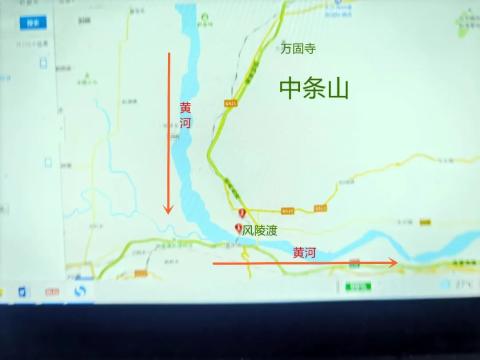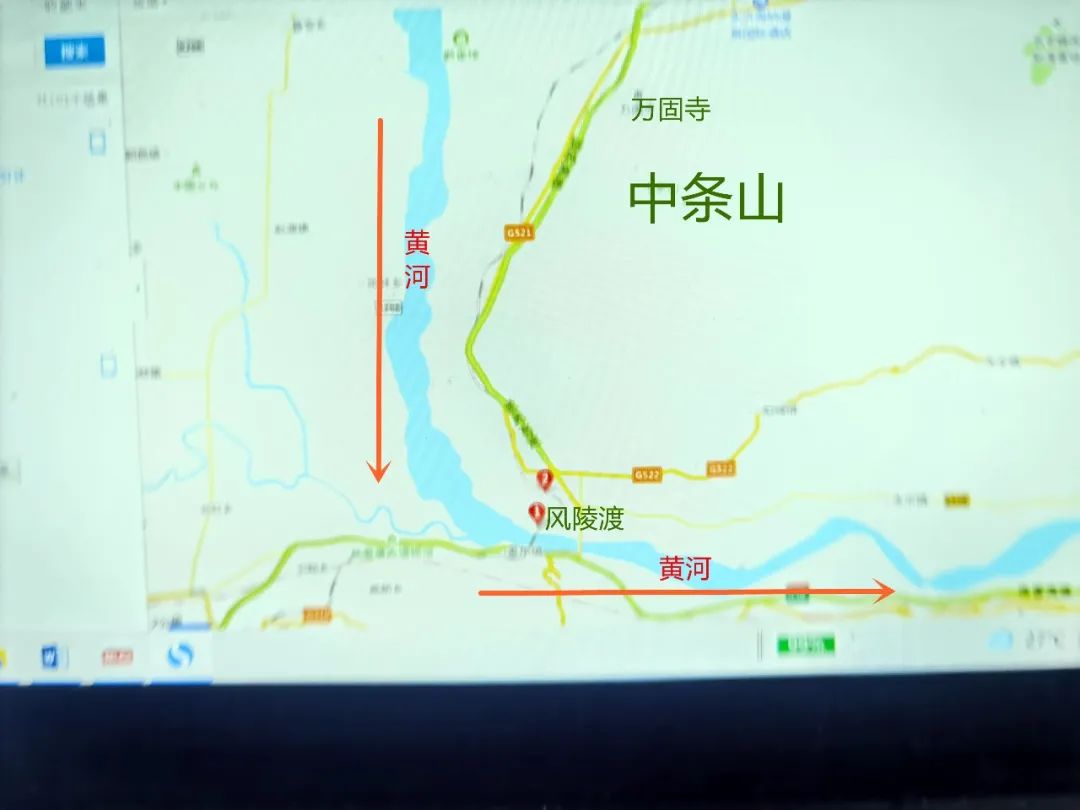
After leaving Fenglingdu, I found some information, which highlighted the historical stories that happened in Fenglingdu during the Anti-Japanese War, and I would like to share them with you.

5. Anti-Japanese bloody battle Fenglingdu
In August 1938, an infantry regiment of the 20th Division of the Japanese invaders, equipped with artillery, cavalry, and tanks, attempted to break through the Chinese defenders' defense positions in Yongji County, seize Fenglingdu, and threaten the Longhai Railway.

(The picture shows the map of the Japanese army: the black is the Yellow River, the red arrow is the direction of the Japanese army’s advance, and the blue dot is the Tongguan natural barrier)
Yongji City is located on the edge of Fenglingdu, so it is the first barrier for the Kuomintang troops to defend Fenglingdu. In order to defend Fenglingdu and prevent the Japanese army from crossing the river, the Kuomintang troops deployed heavy troops here.

One day in mid-August, a brigade of the Japanese Kawagishi Division rushed into the rear of the garrison position from Yao Wentai. Commander Sun Weiru of the 31st Army Group urgently mobilized a teaching group to regain the positions occupied by the Japanese army.

Regiment leader Li Zhenxi quickly led the first and third battalions to kill the Japanese army. The fierce fighting lasted until 4 o'clock in the afternoon, when Li Zhenxi recaptured Wangu Temple and two cannons. The third battalion commander Zhang Xiwen led his troops to pursue the Japanese army and was ambushed by the Japanese army in Xiyaowen Village. The fierce battle lasted from the evening of the first day to the morning of the second day. The Japanese army continued to increase troops, and only 100 people of the third battalion were left. At this time, regiment leader Li Zhenxi was also besieged by the Japanese army and was unable to spare his troops for rescue.

(The picture below shows an old photo of Li Zhenxi)
Facing several times the number of Japanese troops, the Third Battalion was isolated and helpless, and fought bloody battles with the Japanese troops until 10 o'clock in the morning, and all of them died heroically.

After the Japanese army captured Xiyaowen Village, they immediately turned their attack target to Yongji City. On August 17, the Japanese army surrounded Yongji City from the east, south and north. At about five o'clock in the afternoon, Yongji City was captured by the Japanese army.

After the fall of Yongji City, only Hanyang Town remained as the barrier of Fenglingdu. At this time, since the national army had retreated into Zhongtiao Mountain, the task of guarding Hanyang Town fell to the only two battalions of the teaching regiment. The leader of the teaching group, Li Zhenxi, ordered all the brothers to dig a ditch in front of the position and prepare to fight the Japanese army to the end.

Hanyang Town was only 30 li away from Fenglingdu. Li Zhenxi ordered all the young and old in the town to go out and demolish the bunkers built by the Japanese army. Will Construction of rails and sleepers. On August 20, a Japanese infantry squadron and about 50 cavalrymen, under the cover of three tanks, thought that Hanyang Town had no defenders and marched into Hanyang Town in a swagger.

Captain Li led the commando team to dispatch quickly. After three hours of fierce fighting, the Japanese tanks were destroyed and most of the Japanese were annihilated. At this time, the Japanese army had eight to nine hundred infantrymen and more than a dozen tanks coming from Yongji City for reinforcements. Li Zhenxi had already arranged for Wei Hongji, deputy commander of the regiment, to ambush in the bamboo forest outside the town. The Japanese army was attacked head-on, and fierce fighting broke out inside and outside the town.

The fierce fighting lasted until dark, and most of the Japanese troops were wiped out. The remaining soldiers escaped back to Yongji City with the help of reinforcements. In this battle, Lieutenant Colonel Wei Hongji, deputy lieutenant colonel, was killed, and more than 300 brothers were killed or injured. What moved people to tears most was that during the fierce fighting, nearby villagers came to help with sickles and hoes, and many Japanese wounded soldiers were beaten to death.

The Japanese army suffered such heavy losses that they did not dare to attack Hanyang Town again for a week and only sent planes to bomb. Captain Li Zhenxi gained valuable time to mobilize manpower to repair the fortifications again. At the same time, he vigorously dug holes and built solid defenses.

The teaching regiment (only two battalions) and thousands of town residents faced nearly two brigades (1,500 people) of Japanese troops and blocked the Japanese troops for 15 days. The Japanese were unable to move in front of Hanyang Town. Finally, the Japanese army deployed heavy artillery and soldiers to outflank Hanyang Town and stormed Hanyang Town. Li Zhenxi led the teaching group to fight the Japanese army in a bloody battle, but was outnumbered. In the end, Hanyang Town was captured by the Japanese army.

After the war, many Japanese officers and soldiers who participated in the battle wrote in their memoirs their admiration for the warriors of the national army guarding Fenglingdu. These Shaanxi soldiers were known as the "iron pillars."

Hanyang Town fell and Fenglingdu fell into the hands of the Japanese army. The 31st Army of the Kuomintang was reorganized into the 4th Army, with Sun Weiru as commander-in-chief. They set up a 300-mile front line at Zhongtiao Mountain, and the Anti-Japanese War entered the Zhongtiao Mountain Battle stage. In the bloody battle of Fenglingdu, although the teaching regiment failed to save Fenglingdu, it bought time for the deployment of the Zhongtiao Mountain battlefield and delayed the Japanese offensive.

Information: The Battle of Zhongtiao Mountain between China and Japan in the early days of the Anti-Japanese War.
Zhongtiao Mountain in the northeast of Fenglingdu was once dejectedly called the "cecum" by the Japanese invaders. In the early days of the Anti-Japanese War, the Japanese army deployed more than 100,000 troops and fought hard for three years, unable to cross Zhongtiao Mountain. During the eight years of the Anti-Japanese War, the Japanese army occupied large areas of territory in the east, south and north, but had been unable to advance westward. The "Lengwa" of Qin Opera on Zhongtiao Mountain, who had poor weapons and equipment and were marginalized by the Central Army, blocked the Japanese invaders with their lives. One of the reasons. The Battle of Zhongtiao Mountain was very tragic, and there is one detail worth remembering: In June 1939, the fiercest battle, more than 800 remaining members of the 177th Division's new regiment, which had run out of ammunition and food, were forced into a 180-meter building on the bank of the Yellow River. On a cliff more than meters high, 800 soldiers knelt down to worship their hometown before collectively jumping into the river.

Looking at the eight years of the Anti-Japanese War, the main reason why the Japanese invaders were still unable to advance westward into Shaanxi was the lack of strength of the Japanese invaders and the persistent resistance of the Chinese military and civilians.

6. The tragic result of the Fenglingdu air battle
In early March 1938, the Japanese army attacked Puzhou in southwestern Shanxi (now Yongji City, Shanxi, on the east bank of the Yellow River and west of Fenglingdu). He wanted to cross the Yellow River south here, occupy Tongguan, and enter Henan and Shaanxi. Relying on the natural danger of the Yellow River, China and Japan fought fiercely in this area for more than ten days.

On March 8, 1938, 22-year-old Luo Chunting and 12 other pilots took off from Xi'an in 12 E-15 fighter planes and bombed the Japanese artillery position on the bank of the Yellow River in Fenglingdu Town. When they returned from the mission, they were attacked by more than 30 Japanese fighter planes intercepted. Caught off guard, with insufficient ammunition and fuel, it was not suitable to fight. Luo Chunting and another pilot Rong Guangcheng covered the retreat of 10 fighter planes, and fought from the sky above Huayin, Shaanxi Province to near Naihe Village, Fenglingdu Town, Shanxi Province. Due to being outnumbered, Rong Guangcheng and Luo Chunting's fighter planes were unfortunately hit.

(The picture shows the Japanese troops inspecting the wreckage of the downed Chinese E-15 aircraft by the Yellow River)
Luo Chunting was originally from Hangzhou, and his grandfather’s generation moved to Qingdao. Second lieutenant pilot of the 17th Squadron, 5th Group, Kuomintang Air Force

However, the Japanese army only found the wreckage of two planes and the remains of one pilot. According to the information left on the plane, the Japanese army mistakenly identified the body of martyr Rong Guangcheng as Luo Chunting.

(Pictured above: Luo Chunting’s belongings found by the Japanese army from the wreckage of the plane)
Two days later, the Japanese army buried the body and erected a wooden monument with the inscription "Grave of the late Chinese aviation officer Luo Chunting" and took photos.
Two months later, after the Chinese army regained Fenglingdu, they transported the body of the fallen pilot back to Xi'an. The examination found that it was Rong Guangcheng, and they posthumously recognized Rong Guang as an anti-Japanese martyr, but Luo Chunting never found out.

In fact, Luo Chunting was familiar with water properties. He fell into the Yellow River after parachuting and swam ashore quickly. But for some unknown reason, he suffered a brain injury and became unconscious, wandering around Ruicheng County begging for food. Later, he was taken in as a "tenant" by a large family in Dongzhang Village until his death in 1979.

When Luo Chunting disappeared, his wife Ma Jinzhang was more than three months pregnant and had no choice but to remarry her husband's comrade Li Tingkai. On September 17 of the same year, Luo Yihui, Luo Chunting's flesh and blood, was born in Chongqing, and was later renamed Li Liling. In 1949, the family went to Taiwan with the Kuomintang. When Li Liling grew up, she settled in California, USA.

In 1983, Ma Jinzhang told his 45-year-old daughter Li Liling that Li Tingkai was her stepfather and Luo Chunting was her biological father. Therefore, Li Liling traveled to China, Japan, the United States, Canada and other places for 15 years to search for air combat files from that year, visit her father's former comrades, and solve the mystery of her father's disappearance.

In June 1998, "Yuncheng Daily" published the news about Li Liling's search for Luo Chunting and the photos of her disappearance. They happened to be seen by the Xiao family in Dongzhang Village, and the mystery of Luo Chunting's disappearance for more than 60 years was solved. At this time, Luo Chunting had been dead for 20 years. This tragic experience of the hero can't help but make people sigh.

